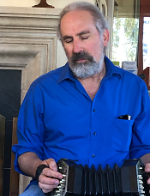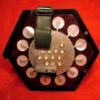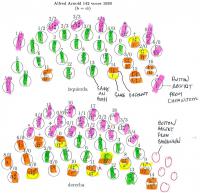-
Posts
350 -
Joined
-
Last visited
Contact Methods
-
Website URL
http://ciceroconcertina.weebly.com
Profile Information
-
Gender
Male
-
Location
Chicago, Illinois, USA
Recent Profile Visitors
2,030 profile views
Theodore Kloba's Achievements

Chatty concertinist (4/6)
-
Theodore Kloba started following Advice request concerning 8 Chemnitzer concertinas for sale
-

Advice request concerning 8 Chemnitzer concertinas for sale
Theodore Kloba replied to blatherskite's topic in Buy & Sell
Google Alerts to the rescue... Not much I can say about these instruments with so few photos, but if some are playable the $1000 price tag might be OK. Is your goal to learn how to play, to learn how to repair and maintain, or to resell? If the Pearl Queen were in good shape and a 52-button (rather than apparent 39-button), it would easily be worth the $1,000 all by itself. It might be a fun instrument to play, but with the older keyboard layout you may find it limited, depending on the type of music you play. (It won't be fully chromatic.) The Lange/Uhlig may have a different keyboard layout from the one that's more-or-less standard among US players. The Polonia is a "private label" for a music store that used to be on Chicago's Southwest Side. I'm not sure who built instruments for them, but since they were already in business ca. 1920 it was most likely one of two "big names" in Chicago at that time: Patek (also built Pearl Queen) or Star. -
Jim is correct. This is a Bandonion, which is to say an earlier version (i.e. having fewer buttons) of what would become the Bandoneon when it made its way to South America. Since it was repaired by Foerster & Sons, you could guess that it was built no more recently than the 1920s. Since it says Saxony rather than Germany, I believe it indicates at least pre-1918. (I can't remember whether "Saxony" would still have been used on products after Saxony joined the German Empire in 1871.) Another clue on the age is the reed plates: They are made of zinc. Shortly after aluminum refining became cost-effective in the last years of the 19th century, zinc was abandoned and aluminum was used for reed plates. There is no source for spare parts, other than finding additional similar instruments in worse repair to scavenge. I have worked on an even older Bandonion (with 44 buttons) and fabricated anything I needed (mostly wood parts, and some springs). All leather parts most likely will have to be replaced. I have bought leather from Columbia Organ Leathers. Most of the Chemnitzer shops in business will probably advise against paying for repair of this instrument due to the cost involved, and the fact that they're more accustomed to working on post-WW2 American-made instruments with aluminum action. It can however be a fun project for a hobbyist.
-
That poor thing sure has taken quite a beating. Broken treble buttons, reeds dislodged from blocks. I bet it was dropped. I have never seen the buttons on these "crumble" as the seller described. These are usually very durable instruments though extremely accordiony in tone and a good shoulder workout as they're so heavy. Putting "Star" in the title is just clickbait as it was only repaired by Star sometime before the 1960s (judging by the Milwaukee avenue address with no ZIP code on the stamp). Not an unusual number of reeds at all, though. Typical for a quad. In fact many quads have extra helicon reeds for buttons 1, 5 & 10 (So you can play the root notes of chords in the common keys).
-
Playing only the melody is not too uncommon in a band setting, but if he were playing it solo with chords the bellows direction would be right for it. Notice that he changes directions with the chord progression: I (A) is on press and IV/V (D/E) are on draw. Since the left keyboard is much more limited than the right, most songs are arranged for bellows direction based on chord changes. In the common major keys, it generally works out that the I chord is in the opposite direction of IV & V. As someone who played bass guitar long before concertina, I also notice that there's a long stretch where the bass player must be finger tapping on his (hidden) left hand since the bass notes are heard but his visible right hand is not moving. I have met "Father Norb" who posted this video and hundreds of others he's shot locally. He's not really clergy, but there's a funny story behind his nickname involving a Sunday morning golf game.
-
If this were a post-1930s American-made instrument, I would say yes, that's usually correct as those instruments will have an aluminum action and potentially some other accordion-like construction features. You may find an accordion technician who can successfully work on it, but you will want to make sure that the person working on it actually knows what they are dealing with. I have a 44-button bandonion of similar vintage (See https://commons.wikimedia.org/wiki/File:Early-bandonion.jpg for photo). I have done work on it (and one 1920s era German instrument) myself and will offer the following: A continuously sounding note may indicate that one of the levers has warped and the pad is no longer aligned with its respective opening. A continuously sounding note might also indicate that one of the springs has weakened with age. They're not hard to fabricate with some piano wire wrapped around a rod. Later instruments have the springs at the "pad end" of the lever so they put pressure directly onto the seal. Also note that if you pull the main hinge pin out on one like yours, the levers will go flying into the air in sequence if you don't restrain them first. The leather disc hinges are fragile, and handling the pads will probably pull some of the hinges apart. They're easy to replace if you have some leather and a hollow punch. I buy my leather from an organ builder, Columbia Organ Works. The hinges on the outer row of buttons (leather sandwiched between wood) are also usually fragile, but also replaceable (though more difficult than the hinges). Removing the reed plates for tuning may end up requiring replacement of the leather gaskets between the reed block and plate. This is tedious work, and the inner partitions of the reed blocks can be very fragile, depending on the construction method. Aside from blowing out with compressed air, the buzzing reeds might be fixed by a slight rotation of the reed tongue about its rivet (use a pair of pliers at the root of the reed; never push the free end side to side). On a little box like this, it may prove difficult to sustain notes for this type of music, though it couldn't hurt to try. I have never heard anyone playing anything like this, but of course nearly all of the players I know personally are older Catholics of East European Descent, in the urban North US, so Sacred Harp/shape note songs are probably about as foreign to them as an Uzbeki Shashmaqam. Incidentally, I find parallel 6ths a more natural harmony on these instruments. That could definitely be fun, and challenging. This instrument was probably built around the time those styles were emerging. I look forward to hearing how it comes along.
-
Definitely a Chemnitzer layout: Note that the "0" keys are to the right of the "4" keys. On other German concertina layouts, the "0" is to the left. The layout is a subset of the 52-button version. You can download a chart from my site here: http://ciceroconcertina.weebly.com/downloads.html I would not expect it to be in A=440 Hz, or in equal temperament. As for the stamped metal "Concertina" grille, I believe these were made by suppliers who sold to many instrument builders. Only the large factories (like Alfred/Arno Arnold) stamped their own with a company name/logo. If no maker's name is on the inside, the wing-shaped pattern of the holes on the treble side (under the heel of the hand) may help identify it. I think the square (i.e. not chamfered) corners put it's age pre-WWI. The material of the reedplates (zinc vs. aluminum) may also help tell the age.
-

Old News But Maybe New To You: Nasoalmo 2013.
Theodore Kloba replied to Theodore Kloba's topic in Concertina Videos & Music
Thanks, wolf! Incidentally, for those that may not want to wade through the other stuff, all of the Concertina tracks on my SoundCloud are in one playlist: https://soundcloud.com/oakbloodthree/sets/concertina -
I was browsing C.net because MatthewVanitas summoned me to the forums for a Chemnitzer emergency, and it occurred to me I had never posted anything about my NaSoAlMo* 2013 entry. Only one song ended up using my [Chemnitzer] concertina: "One By One" *NaSoAlMo is National Solo Album Month. The idea is to write and record an entire album's worth of music in the month of November, all by yourself. No previously written songs, no help from other musicians, engineers, etc. The result of my effort is here: Difficult Fractionations. 2013 was my first try at it. I'm not sure if I will do NaSoAlMo 2014. Maybe some others here will!
-
Thanks, Matthew. It's at least a little amusing. Though the name badge is not shown on the auction page, I think these were sold under the Stradivarius brand and made in Italy. I have seen a couple of these in person and to me they're little more than an expensive novelty: Incredibly heavy (even for a chemnitzer), and very accordiony tone (... even for a chemnitzer ...) 52 buttons. I think that would be 104 notes/tones in Chemnitzer terminology. Here's a layout. And it looks like the right hand has stops for different voices, something I've never seen before on a Chemnitzer, though I'm hardly an expert. That 5-stop radio-button configuration was very common on the Italian-made models. Definitely a contributor to the weight, and implemented on the reed blocks in a similar fashion to register switches in an accordion. One of my Star concertinas has a single switch that shuts off the low-octave reed, but it is accomplished by a slider in a groove on the valveboard. The "high-low" switch on the Star is more common on the American makes. ...now I have to find the "inherited Chemnitzers" thread... Edited to say: just found it, and what do you know: another Stradivarius!
-

44 Buttons ?chemnitzer/carlsfelder? Concertina
Theodore Kloba replied to Damaya's topic in Concertina History
It's probably a Carlsfelder: Maria Dunkel's Bandonion und Konzertina says that there was a 44-button version produced with 20 buttons on bass & 24 on treble like this one. The Chemnitzers generally were 38, 39, 51 or 52 buttons. There was also a 44-button Bandonion (I have one) but by the time Bandonions reached 44 buttons, there were 4 rows on the bass side.- 9 replies
-
- chemnitzer
- 88 tones
-
(and 2 more)
Tagged with:
-
I just found this on a discussion group about IP.Board modifications: http://invisionmodding.com/tutorials/article/621-soundcloud-bbcode-ipboard-23x/ It would allow embedding of SoundCloud audio into posts with bbcode like this: [sc]http://soundcloud.com/user/audio-name[/sc] It would be nice over in the Tune of the Month discussion in particular. Thoughts? PS the post is a bit old, so there may be a more recent embedding code for SoundCloud to use.
-
All: I notice several users are posting recordings here (or in Tune of the Month threads) on Soundcloud. Has anyone given thought to creating a Concertina.net soundcloud group? The discussion system there is nothing special, especially when we have this forum, but it might be a nice way to share and discover our own recordings. (Incidentally: https://soundcloud.com/oakbloodthree/sets/concertina )
-
Somehow I missed this thread in my "great Chemnitzer sweep" last week. Matthew, did your Clarinetist friend ever try taking up bandoneón, by way of Chemnitzer or otherwise? It seems to me some important points were missed in the discussion, that could have value to this or similar situations. First for someone who only plays clarinet (if that was in fact the case), there are other challenges to overcome first in transitioning to bandoneón: Learning to use right and left hand independently to create separate melody/harmony. Learning to handle the bellows & air valve. Learning to handle the instrument itself (weight, balance, size, etc.). Learning to read bass clef, and then play from two staves of notation. Any of these could be managed in a basic sense with a Chemnitzer, at least until a suitable, playable bandoneón is found. Probably no more than she would harm her Clarinet abilities by borrowing a friend's saxophone for a while. Actually, the left hand of the chemnitzer shares 17 buttons completely in common with the bandoneón. Three more match in one bellows direction. Four of the chemnitzer's buttons are completely different, and then the bandoneón adds 9 buttons around the perimeter to extend the range. When I picked up my 44-button bandoneón, I had no problems adapting to the left hand. (The 44-button is a subset of the standard tango type and its 23 left hand buttons include all of the common or half-common buttons with the chemnitzer's 24 left hand buttons.) The right hands are not quite so similar, with only 9 (or 10*) buttons completely the same (spread across parts of all 3 rows), another 7 (or 6*) buttons matching in one bellows direction and 7 not matching at all. The bandoneón was extended in range with 3 outer rows, while the chemnitzer extends all 3 rows with a couple extra buttons. Even so, it doesn't take me hitting too many wrong notes to adapt if I pick up the bandoneón after a long stretch away from it. If I keep both chemnitzer & bandoneón practiced, switching is easy. That's the most common keyboard layout for tango players, though not the only one. I don't think there's necessarily "un-learning and re-learning" involved. Just that some of the things learned don't carry over. On a 20-button Anglo, you're certainly going to be handling the bellows very differently and a lot of the notes simply won't be there. The general way of playing across the rows translates more closely from chemnitzer. Ultimately though, availability is going to make a difference and either would help someone get the feel of playing a bellows instrument. *there is one button that varies on older chemnitzers.
-

Building Hayden Duett
Theodore Kloba replied to Łukasz Martynowicz's topic in Instrument Construction & Repair
I didn't think it was a space issue, since the Manage Attachments page says: You have used 944.01KB of 7.81MB. In any event, I found a photo online of an A.A. Chemnitzer with the layered mounting. Here it is: Found at Pictures of Bandoneons.- 78 replies
-
- Construction
- Building
-
(and 2 more)
Tagged with:
-

It's Still A Konzertina!
Theodore Kloba replied to harpomatic's topic in General Concertina Discussion
I'll have to check to be sure, but I think Ruvolis were built by (or at least for) the same people who owned Star right before John Bernhardt bought the company and revamped the manufacturing completely. One of them was Pompilio Rosiani who (AFAIK) still does repairs at Italo-American.






